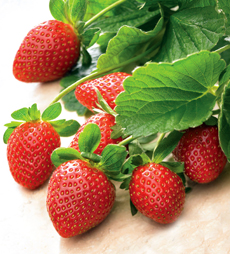

Beautiful strawberries, freshly picked. Photo courtesy Florida Strawberry Growers Association.
January 2010
|
 |
Buy Strawberries For Taste & Health
Make Fresh Strawberries A Fruit Of Choice In Your Home
Strawberries are one of our favorite foods: delicious, nutritious and low in calories. That’s the Food Trifecta!
California and Florida are the principal U.S. strawberry-growing regions: Florida for winter berries, California for spring, summer and fall fruit. Florida strawberry growers began hand-harvesting the first fruit of the winter strawberry season in late November; and while there are imports, Florida is the major supplier of strawberries in the U.S. from November through early spring.
Strawberry History
They’re originally from northern Europe, but wild strawberries grow in many locations, including the United States. The fruit dates back to the Roman Empire, and possibly to the Greeks before them.
The strawberry got its name from the common practice of growing berries under straw to protect them from frost. The first American species of strawberry was cultivated about 1835. Today, the strawberry is the leading small fruit crop in the U.S., with the largest strawberry growing centers located in California and Florida.
The strawberry is a member of the rose family, which is why the strawberry plant sometimes gives off a rose-like aroma. A greenish-white fruit grows from the flower and eventually ripens into a deep red berry.
Before modern refrigeration, the fruits were picked and in short order consumed—as fresh fruit, in pies, tarts and shortcake. The berries were preserved as jam, jelly, sauce, strawberry vinegar and strawberry tonic, a medicinal drink; and were dried on flat rocks for several days, to be used throughout the fall and winter in breads, cakes and puddings.
Many different varieties of strawberries are cultivated, and each has a specific color, flavor and texture (firm flesh is needed to ship long distances, for example). The particular climate and soil dictate which variety of strawberry will grow best; some varieties grow early in the season, some later. Strawberries must be picked at the peak of ripeness for optimum flavor, as they do not continue to ripen after they’re picked.
Strawberry Trivia
- The strawberry is the only fruit to carry its seeds on the outside.
- There are 200 seeds on the average strawberry. Each of these seeds has the genetic potential to become a new variety of strawberry since no two seeds are the same. This is how plant breeders develop new varieties of strawberries.
How To Buy Strawberries
- Select berries that are firm, fragrant, plump and bright-glossy red. Their caps should be bright green and fresh looking. Strawberries don’t ripen after harvest.
- Use strawberries as soon as possible after purchasing, ideally within two days.
- Keep the berries cool. Store in the refrigerator until ready to use. The perfect storage temperature for strawberries is 32°F to 36°F.
- The best place to store the berries is in the crisper drawer of the refrigerator, in clamshell containers or opened plastic bags to maintain high humidity.
Using Strawberries
- Berries taste best at room temperature, so remove them from the refrigerator an hour or two before serving.
- To help berries retain flavor, texture and nutrients, avoid washing or removing their caps until ready for use.
- Remove the green caps with a light twisting motion or with the point of a paring knife. It’s as easy as a twist of the wrist.
- Let drain, then pat dry after washing.
Healthy Serving Suggestions
- While there are many elaborate strawberry recipes, the simplest is to enjoy them whole, straight from the bowl.
- If you’d like them a little sweeter, consider a non-caloric sweetener or agave syrup, a much more nutritious and low-glycemic alternative to sugar (it’s delicious, too).
- Strawberries and cream are a centuries-old favorite; but you don’t need to go full-force on the cream calories. Whole milk is fine (or nonfat, if you’re counting fat calories).
- The modern variety: dip strawberries in plain nonfat yogurt; or sweeten the yogurt with non-caloric sweetener and cinnamon.
- A tasty dessert or snack: Add fresh strawberries to sweetened nonfat yogurt and top with a tablespoon of granola.
- Look for reduced-calorie or fat-free whipped cream products for a fancier garnish.
- What could be better than topping No Sugar Added vanilla ice cream or frozen yogurt with fresh strawberries? If the strawberries are large, slice them.
- Or, make a strawberry milkshake: 5 scoops No Sugar Added vanilla ice cream, 2 cups strawberries, 2 cups milk; combine and mix in a blender.
Strawberry Nutrition
Strawberries are rich in antioxidants. Studies in rodents at Ohio State University found
that berries inhibited the development of oral, esophageal and colon cancers.
- Strawberries are nutritious. Eight strawberries contain more vitamin C than one orange, and have 149% of your Daily Value for vitamin C.
- Strawberries are low-calorie. A one-cup serving (about 8 to 10 medium-sized berries) contains 45 calories.
- Strawberries are fat-free and salt free: no fat, no cholesterol, no sodium.
- Strawberries are also rich in vitamins A and C, folic acid, selenium, calcium polyphenols such as ellagic, ferulic and coumaric acids, quercitin, anthocyanins and phytosterols. They contribute 29% of your Daily Value of manganese.
|


